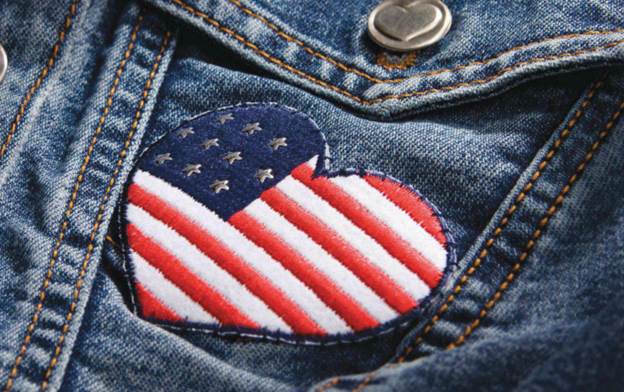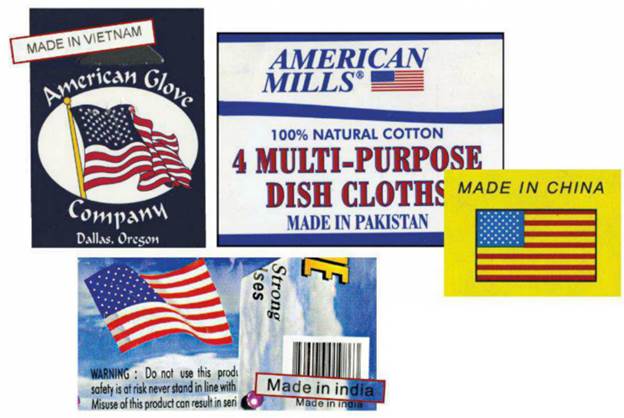How to know which flag-waving products
are true red, white, and blue
Given a choice between
a product made in the U.S. and an identical one made abroad, 78 percent of
Americans would rather buy the American product, according to a new nationally representative
survey by the Consumer Reports National Research Center.

How to know which flag-waving products
are true red, white, and blue
More than 80 percent
of those people cited retaining manufacturing jobs and keeping American
manufacturing strong in the global economy as very important reasons for buying
American. About 60 percent cited concern about the use of child workers or
other cheap labor overseas, or stated that American-made goods were of higher
quality.
And people would pay
extra to buy American. More than 60 percent of all respondents indicated they’d
buy American-made clothes and appliances even if those cost 10 percent more
than imported versions; more than 25 percent said they’d pay a least an extra 20
percent. (Perhaps more surprising: According to a new survey of consumers in
the U.S. and abroad by the Boston Consulting Group, more than 60 percent of
Chinese respondents said they’d buy the American-made version over the Chinese
even if it cost more.)
Clearly, most
Americans want to know where products are made and want to buy those that will
help create or keep jobs in the U.S.- an attempt applauded by economists like
Jeff Faux, a distinguished fellow of the nonprofit, nonpartisan Economic Policy
Institute, in Washington, D.C. “Consumers need to understand that all jobs and
wages are interconnected,” Faux told us. “When you buy foreign goods-and sometimes
there’s no choice – it means that fewer U.S. workers will have the money to buy
the goods and services you sell.”
But what does “made in
the USA” even mean? And how can you identify what’s made where?
In this special
report, we’ll decipher labeling laws and explain why a product that pictures an
American flag might be made abroad, identify companies that still make products
in the U.S., hear from economists about manufacturing trends, and provide our experts’
assessment of the quality of some American-made apparel.
A guessing game
Few products except
cars, textiles, furs and woolens are required by law to reveal their American
heritage. But when any manufacturer chooses to boast of an American connection,
it must comply with federal rules designed to keep consumers from being misled.
Our evidence shows
that if not misled, consumers are at least confused.. Readers flood with
letters and e-mail seeking explanation as to why, for example, frozen
blueberries from Oregon are identified as a product of Chile; why a company
named Florida’s Natural sells apple juice with concentrate from Brazil; why
pants made in Vietnam are labeled “authentic, active, outdoor, American”, or
why a T-shirt with the words “Made in the “above the U.S. flag comes from
Mexico.

These are just a few of the labels that
have puzzled readers recently. Law allow for flags, eagles, and such, as long
as the manufacturer clearly identifies where the product was made.
Though perplexing,
such words and pictures don’t usually violated regulations that are issued by
the Federal Trade Commission, the agency responsible for protecting consumers from
false or deceptive product claims. The key factors in determining whether a
“Made in the USA” claim is deceptive, says FTC senior attorney L. Koss, are the
claim’s context and whether it’s likely to mislead a reasonable consumer.
Ultimately, the line between legal and illegal is determined by the overall
impression planted in consumers’ minds.
But the line is
blurry. Every case is different and subject to interpretation, Koss says. Most
of the complaints the FTC receives are initiated by companies that are pointing
a finger at competitors they claim are seeking an unfair advantage.
When a company
definitely crossed the line, the FTC’s priority is stopping the behavior, not
punishment. If a company refuses, it faces civil penalties-in theory. In
practice, the FTC has brought only once civil penalty case since the late
1990s, slapping toolmaker Stanley with a $205,000 fine in 2006 to settle
charges involving the pedigree of its Zero Degree ratchets. (Stanley claimed
that the ratchets were made in America, but the FTC noted that much of their
content was foreign.)
The types of claims
“Made in the USA”
claims can be “unqualified” or “qualified.” Unqualified means that “all or
virtually all” significant parts and processing are of U.S. origin. The product
may contain a small amount of foreign ingredients if they’re not significant-
the knobs of a barbecue grill, for instance. Companies must be able to document
any claim.

The product may contain a small amount
of foreign ingredients if they’re not significant- the knobs of a barbecue
grill, for instance.
Qualified claims, the
main cause of confusion, come in many forms, but each must tell the whole
story. Take the new iPad Mini. The packaging says, “Designed by Apple in
California, Assembled in China.” That’s an acceptable claim. By contrast, a company
could land in trouble if it said “created in the U.S.” without specifying the
country of manufacture, since consumers are likely to interpret a vague, stand-alone
term like “created” as all-inclusive. The FTC requires companies to post
prominent, unambiguous statements (such as the actual country of origin) to
leave an accurate impression. Reader who have sent us complaints seem most
irritated by foreign-made products whose makers have patriotic names (American
Mills, Americana Olives, Great American Seafood, United States Sweater, the U.S
Lock company) or whose packages have flag-waving slogans (“true American
quality”) or symbols (picture of the flag, eagle, Stature of Liberty). But all
of those products are likely to be legal as long as they leave a clear
impression about where they’re made.